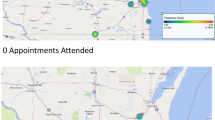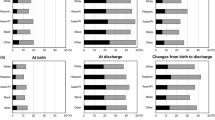Abstract
Objectives
Infant Follow Up Programs (IFUPs) provide developmental surveillance for preterm infants after hospital discharge but participation is variable. We hypothesized that infants born to Black mothers, non-English speaking mothers, and mothers who live in “Very Low” Child Opportunity Index (COI) neighborhoods would have decreased odds of IFUP participation.
Study design
There were 477 infants eligible for IFUP between 1/1/2015 and 6/6/2017 from a single large academic Level III NICU. Primary outcome was at least one visit to IFUP. We used multivariable logistic regression to identify factors associated with IFUP participation.
Result
Two hundred infants (41.9%) participated in IFUP. Odds of participation was lower for Black compared to white race (aOR 0.43, p = 0.03), “Very Low” COI compared to “Very High” (aOR 0.39, p = 0.02) and primary non-English speaking (aOR 0.29, p = 0.01).
Conclusion
We identified disparities in IFUP participation. Further study is needed to understand underlying mechanisms to develop targeted interventions for reducing inequities.
This is a preview of subscription content, access via your institution
Access options
Subscribe to this journal
Receive 12 print issues and online access
$259.00 per year
only $21.58 per issue
Buy this article
- Purchase on Springer Link
- Instant access to full article PDF
Prices may be subject to local taxes which are calculated during checkout
Similar content being viewed by others
References
Matoba N, Collins JW. Racial disparity in infant mortality. Semin Perinatol. 2017;41:354–9. https://doi.org/10.1053/j.semperi.2017.07.003.
Martin AE, D’Agostino JA, Passarella M, Lorch SA. Racial differences in parental satisfaction with neonatal intensive care unit nursing care. J Perinat. 2016;36:1001–7. https://doi.org/10.1038/jp.2016.142.
Sigurdson K, Mitchell B, Liu J, Morton C, Gould JB, Lee HC, et al. Racial/ethnic disparities in neonatal intensive care: a systematic review. Pediatrics. 2019:e20183114. https://doi.org/10.1542/PEDS.2018-3114.
Boghossian NS, Geraci M, Lorch SA, Phibbs CS, Edwards EM, Horbar JD. Racial and ethnic differences over time in outcomes of infants born less than 30 weeks’ gestation. Pediatrics. 2019;144:e20191106. https://doi.org/10.1542/peds.2019-1106.
Profit J, Gould JB, Bennett M, Goldstein BA, Draper D, Phibbs CS, et al. Racial/ethnic disparity in NICU quality of care delivery. Pediatrics. 2017;140:e20170918. https://doi.org/10.1542/peds.2017-0918.
Saigal S, Doyle LW. An overview of mortality and sequelae of preterm birth from infancy to adulthood. Lancet. 2008;371:261–9. https://doi.org/10.1016/S0140-6736(08)60136-1.
Spittle AJ, Cameron K, Doyle LW, Cheong JL. Motor impairment trends in extremely preterm children: 1991–2005. Pediatrics. 2018;141:e20173410. https://doi.org/10.1542/peds.2017-3410.
Adams-Chapman I, Heyne RJ, DeMauro SB, Duncan AF, Hints SR, Pappas A, et al. Neurodevelopmental impairment among extremely preterm infants in the neonatal research network. Pediatrics. 2018;141:e20173091. https://doi.org/10.1542/peds.2017-3091.
Litt JS, Edwards EM, Lainwala S, Mercier C, Montgomery A, O’Reilly D, et al. Optimizing high-risk infant follow-up in nonresearch-based paradigms. Pediatr Qual Saf. 2020;5:e287. https://doi.org/10.1097/pq9.0000000000000287.
American Academy of Pediatrics Committee on Fetus and Newborn. Hospital discharge of the high-risk neonate. Pediatrics. 2008;122:1119–26. https://doi.org/10.1542/peds.2008-2174.
Kuppala VS, Tabangin M, Haberman B, Steichen J, Yolton K. Current state of high-risk infant follow-up care in the United States: results of a national survey of academic follow-up programs. J Perinatol. 2012. https://doi.org/10.1038/jp.2011.97.
Litt JS, Glymour MM, Hauser-Cram P, Hehir T, McCormick MC. Early intervention services improve school-age functional outcome among neonatal intensive care unit graduates. Acad Pediatr. 2018;18:468–74. https://doi.org/10.1016/j.acap.2017.07.01.
Spittle A, Orton J, Anderson PJ, Boyd R, Doyle LW. Early developmental intervention programmes provided post hospital discharge to prevent motor and cognitive impairment in preterm infants. Cochrane Database Syst Rev. 2015. https://doi.org/10.1002/14651858.CD005495.pub4.
McCormick MC, Brooks-Gunn J, Buka SL, Goldman J, Yu J, Salganik M, et al. Early intervention in low birth weight premature infants: results at 18 years of age for the infant health and development program. Pediatrics. 2006;117:771–80. https://doi.org/10.1542/peds.2005-1316.
Callanan C, Doyle L, Rickards A, Kelly E, Ford G, Davis N. Children followed with difficulty: how do they differ? J Paediatr Child Health. 2001;37:152–6. https://doi.org/10.1046/j.1440-1754.2001.00621.x.
Tin W, Fritz S, Wariyar U, Hey E. Outcome of very preterm birth: children reviewed with ease at 2 years differ from those followed up with difficulty. Arch Dis Child Fetal Neonatal Ed. 1998;79:F83–7. https://doi.org/10.1136/fn.79.2.F83.
Mercier CE, Dunn MS, Ferrelli KR, Howard DB, Soll RF. Vermont Oxford Network ELBW Infant Follow-Up Study Group. Neurodevelopmental outcome of extremely low birth weight infants from the Vermont Oxford Network: 1998–2003. Neonatology. 2010;97:329–38. https://doi.org/10.1159/000260136.
Hintz SR, Gould JB, Bennett MV, Lu T, Gray EE, Jocson MA, et al. Factors associated with successful first high-risk infant clinic visit for very low birth weight infants in California. J Pediatr. 2019;210:91–8.e1. https://doi.org/10.1016/j.jpeds.2019.03.007.
Swearingen C, Simpson P, Cabacungan E, Cohen S. Social disparities negatively impact neonatal follow-up clinic attendance of premature infants discharged from the neonatal intensive care unit. J Perinat. 2020;40:790–7. https://doi.org/10.1038/s41372-020-0659-4.
Ballantyne M, Stevens B, Guttmann A, Willan AR, Rosenbaum P. Maternal and infant predictors of attendance at neonatal follow-up programmes. Child Care Health Dev. 2014;40:250–8. https://doi.org/10.1111/cch.12015.
Harmon SL, Conaway M, Sinkin RA, Blackman JA. Factors associated with neonatal intensive care follow-up appointment compliance. Clin Pediatr. 2013;52:389–96. https://doi.org/10.1177/0009922813477237.
Nehra V, Pici M, Visintainer P, Kase JS. Indicators of compliance for developmental follow-up of infants discharged from a regional NICU. J Perinat Med. 2009;37. https://doi.org/10.1515/JPM.2009.135.
Felitti VJ, Anda RF, Nordenberg D, Williamson DF, Spitz AM, Edwards V, et al. Relationship of childhood abuse and household dysfunction to many of the leading causes of death in adults the adverse childhood experiences (ACE) study. Am J Prev Med. 1998;14:245–58. https://doi.org/10.1016/s0749-3797(98)00017-8.
Beck AF, Huang B, Wheeler K, Lawson NR, Kahn RS, Riley CL. The Child Opportunity Index and disparities in pediatric asthma hospitalizations across one Ohio metropolitan area, 2011–2013. J Pediatr. 2017;190:200–6.e1. https://doi.org/10.1016/j.jpeds.2017.08.007.
Acevedo-Garcia D, McArdle N, Hardy EF, Crisan UI, Romano B, Norris D, et al. The child opportunity index: improving collaboration between community development and public health. Health Aff. 2014;33:1948–57. https://doi.org/10.1377/hlthaff.2014.0679.
Kersten EE, Adler NE, Gottlieb L, Jutte DP, Robinson S, Roundfield K, et al. Neighborhood child opportunity and individual-level pediatric acute care use and diagnoses. Pediatrics. 2018;141. https://doi.org/10.1542/peds.2017-2309.
Aris IM, Rifas-Shiman SL, Jimenez MP, Li L, Hivert M, Oken E, et al. Neighborhood child opportunity index and adolescent cardiometabolic risk. Pediatrics. 2021;147. https://doi.org/10.1542/peds.2020-018903.
Bailey ZD, Krieger N, Agénor M, Graves J, Linos N, Bassett MT. Structural racism and health inequities in the USA: evidence and interventions. Lancet. 2017;389. https://doi.org/10.1016/S0140-6736(17)30569-X.
Howell EA, Janevic T, Hebert PL, Egorova NN, Balbierz A, Zeitlin J. Differences in morbidity and mortality rates in Black, White, and Hispanic very preterm infants among New York City hospitals. JAMA Pediatr. 2018;172:269. https://doi.org/10.1001/jamapediatrics.2017.4402.
Janevic T, Zeitlin J, Auger N, Egorova NN, Hebert P, Balbierz A, et al. Association of race/ethnicity with very preterm neonatal morbidities. JAMA Pediatr. 2018;172:1061. https://doi.org/10.1001/jamapediatrics.2018.2029.
Murosko D, Passerella M, Lorch S. Racial segregation and intraventricular hemorrhage in preterm infants. Pediatrics. 2020. https://doi.org/10.1542/peds.2019-1508.
Beck AF, Edwards EM, Horbar JD, Howell EA, McCormick MC, Pursley DM. The color of health: how racism, segregation, and inequality affect the health and well-being of preterm infants and their families. Pediatr Res. 2019. https://doi.org/10.1038/s41390-019-0513-6.
Miquel-Verges F, Donohue PK, Boss RD. Discharge of infants from NICU to Latino families with limited English proficiency. J Immigr Minor Health. 2011;13:309–14. https://doi.org/10.1007/s10903-010-9355-3.
Abdulla L, McGowan EC, Tucker RJ, Vohr BR. Disparities in preterm infant emergency room utilization and rehospitalization by maternal immigrant status. J Pediatr. 2020;220:27–33. https://doi.org/10.1016/j.jpeds.2020.01.052.
Horbar JD, Edwards EM, Greenberg LT, Profit J, Draper D, Helkey D, et al. Racial segregation and inequality in the neonatal intensive care unit for very low-birth-weight and very preterm infants. JAMA Pediatr. 2019;173:455. https://doi.org/10.1001/jamapediatrics.2019.0241.
Bronfenbrenner U. The ecology of human development: experiments by nature and design. Cambridge, Massachusetts: Harvard University Press; 1979.
Reichman V, Brachio SS, Madu CR, Montoya-Williams D, Peña MM. Using rising tides to lift all boats: equity-focused quality improvement as a tool to reduce neonatal health disparities. Semin Fetal Neonatal Med. 2021;26. https://doi.org/10.1016/j.siny.2021.101198.
Wojcik MH, Stewart JE, Waisbren SE, Litt JS. Developmental support for infants with genetic disorders. Pediatrics. 2020;145. https://doi.org/10.1542/peds.2019-0629.
Laing S, Walker K, Ungerer J, Badawi N, Spence K. Early development of children with major birth defects requiring newborn surgery. J Paediatr Child Health. 2011;47:140–7. https://doi.org/10.1111/j.1440-1754.2010.01902.x.
Acknowledgements
We acknowledge Wenyang Mao for her biostatistical support and consultation.
Funding
This work was supported by Agency for Healthcare Research and Quality grant number T32HS000063. YSF was supported by AHRQ grant number T32HS000063 as part of the Harvard-wide Pediatric Health Services Research Fellowship Program.
Author information
Authors and Affiliations
Contributions
YSF conceptualized and designed the study, carried out the analyses, drafted the initial manuscript, and reviewed and revised the manuscript. JES and JSL conceptualized and designed the study, designed the collection instruments, and reviewed and revised the manuscript. All authors approved the final manuscript as submitted and agree to be accountable for all aspects of the work.
Corresponding author
Ethics declarations
Competing interests
The authors declare no competing interests.
Additional information
Publisher’s note Springer Nature remains neutral with regard to jurisdictional claims in published maps and institutional affiliations.
Supplementary information
Rights and permissions
About this article
Cite this article
Fraiman, Y.S., Stewart, J.E. & Litt, J.S. Race, language, and neighborhood predict high-risk preterm Infant Follow Up Program participation. J Perinatol 42, 217–222 (2022). https://doi.org/10.1038/s41372-021-01188-2
Received:
Revised:
Accepted:
Published:
Issue Date:
DOI: https://doi.org/10.1038/s41372-021-01188-2
This article is cited by
-
Association between neurodevelopmental outcomes and concomitant presence of NEC and IVH in extremely low birth weight infants
Journal of Perinatology (2024)
-
A mixed methods study of perceptions of bias among neonatal intensive care unit staff
Pediatric Research (2023)
-
Disparity drivers, potential solutions, and the role of a health equity dashboard in the neonatal intensive care unit: a qualitative study
Journal of Perinatology (2023)



